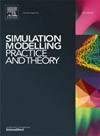电磁铁对增强型霍尔效应放大器纳米器件(HAND)的影响-第1部分:建模和仿真
IF 3.5
2区 计算机科学
Q2 COMPUTER SCIENCE, INTERDISCIPLINARY APPLICATIONS
引用次数: 0
摘要
基于著名的霍尔效应,设计了一种新型的纳米级器件,命名为HAND (Hall Amplifier nanoscale device),目的是在纳米尺度上实现宏观霍尔效应。根据霍尔效应的物理原理,该设备接收电流作为输入,并产生电压作为输出,这意味着它具有低输入阻抗和高输出阻抗。虽然大多数其他基于霍尔效应的纳米级器件都是传感器,但HAND既可以作为放大器又可以作为调制器,并且可以在非常高的频率(几十太赫兹)的电子电路中使用。第一代设备需要在未来制造第二代之前进行几项改进。其中之一是能够将施加磁场增加到更高的值,同时防止设备出现不必要的过热。为此,采用了几种方法,包括改变材料组成、器件几何形状和HAND的其他物理参数。为了准确地预测重新设计的HAND的行为,建立了新的直流条件下器件行为的数学描述,以及经典霍尔效应的全面分析模型。分析结果与数值模拟结果完全吻合,验证了数学模型对螺旋线圈几何形状的影响。这种改进的装置结合了高频操作、放大、霍尔效应和纳米级尺寸,能够彻底改变微电子电路。本文章由计算机程序翻译,如有差异,请以英文原文为准。

Impact of electro-magnets on enhanced hall-effect amplifier nanoscale device (HAND) – part 1: Modelling & simulations
A new version of a nanoscale device, based on the famous Hall Effect, and named HAND (Hall Amplifier Nanoscale Device), was designed and analytically modelled, with the goal of implementing the macro-Hall effect on the nano scale. Following the physics of the Hall effect, the device receives a current as an input and creates a voltage as an output, which means it possesses a low input impedance and a high output impedance. While most other nanoscale devices based on the Hall effect are sensors, HAND operates as both an amplifier and a modulator, and it can be expected to find use in electronic circuits at very high frequencies (tens of THz). The first generation of the device required several improvements in advance of future fabrication of the second generation. One of these was enabling an increase of the applied magnetic field to higher values while preventing undesirable overheating of the device. Several approaches were taken toward this end, including changes to the material composition, device geometry, and other physical parameters of the HAND. A renewed mathematical description of the device behavior in DC condition was developed, as well as thorough analytical models for classical Hall Effect, in order to accurate forecast the behavior of the re-designed HAND. The analytical and numerical simulation results matched fully, validating the mathematical model for the case of a spiral coil geometry. This improved device, combining high frequency operation, amplification, the Hall effect, and nanoscale dimensions, is capable of revolutionizing microelectronic circuitry.
求助全文
通过发布文献求助,成功后即可免费获取论文全文。
去求助
来源期刊

Simulation Modelling Practice and Theory
工程技术-计算机:跨学科应用
CiteScore
9.80
自引率
4.80%
发文量
142
审稿时长
21 days
期刊介绍:
The journal Simulation Modelling Practice and Theory provides a forum for original, high-quality papers dealing with any aspect of systems simulation and modelling.
The journal aims at being a reference and a powerful tool to all those professionally active and/or interested in the methods and applications of simulation. Submitted papers will be peer reviewed and must significantly contribute to modelling and simulation in general or use modelling and simulation in application areas.
Paper submission is solicited on:
• theoretical aspects of modelling and simulation including formal modelling, model-checking, random number generators, sensitivity analysis, variance reduction techniques, experimental design, meta-modelling, methods and algorithms for validation and verification, selection and comparison procedures etc.;
• methodology and application of modelling and simulation in any area, including computer systems, networks, real-time and embedded systems, mobile and intelligent agents, manufacturing and transportation systems, management, engineering, biomedical engineering, economics, ecology and environment, education, transaction handling, etc.;
• simulation languages and environments including those, specific to distributed computing, grid computing, high performance computers or computer networks, etc.;
• distributed and real-time simulation, simulation interoperability;
• tools for high performance computing simulation, including dedicated architectures and parallel computing.
 求助内容:
求助内容: 应助结果提醒方式:
应助结果提醒方式:


